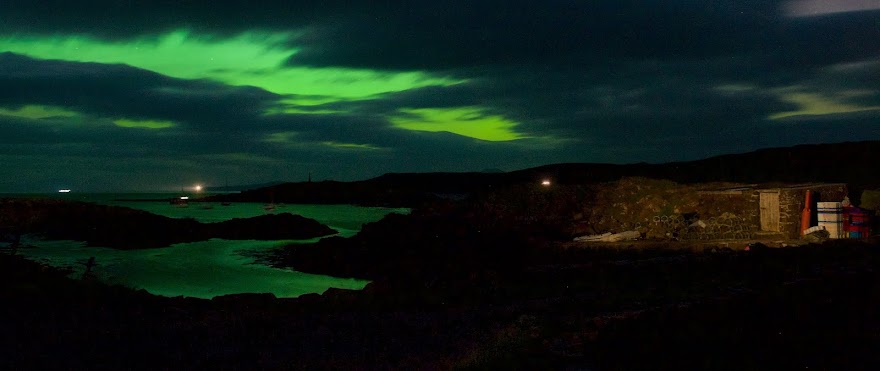
Ice on Loch Cuin at Dervaig on Hogmonay. The courageous driver of the gritting lorry made it as far as the quarry above our turning on Wednesday, so we were able to get out to Dervaig before the shops shut for New Year!
Hogmonay Eve brought a blue moon and a partial lunar eclipse. Seemed like an auspicious signal for the end of the year and of the decade. It was bright and starry - except when I got the camera out to photograph it, a cloud appeared out of nowhere and obscured the shadow on the moon!
The shortest day is now nearly 2 weeks behind us. This prolonged cold spell brings the bonus of sunshine and brilliant blue skies, and clear starry nights. Crunchy iced snow underfoot makes walking on the hill a magical experience. Frozen burns and bog, cascades of thick creamy grey ice tumbling down rock. Red spongy mosses forming hard clumps of colour capped with ice. Sheltered spots with tell tale signs of where deer have been lying, scrubby trees with damaged trunks from stags rubbing them.
We walked up to first foot our neighbours yesterday afternoon. A foursome of brightly breasted bullfinches danced along in front of us as we went along the farm track towards Ensay, dropping onto deer posts, then moving off just as we got close enough for a really good look, and then they did it all over again, and again until we parted company at the edge of the birch woodland. We followed along side the road up the hill towards their house, across the Ensay Bridge, thick thick ice still covering the road. As we neared the house a pair of golden eagles floated slowly overhead.
And as the sun was setting and we started to walk home, the hill glowing softly pink in the sunset light, a Sea Eagle flew eastwards from the Crackaig direction, low and sharply silhouetted against the fading sky. And on the Sitheans, the grassy 'fairy knolls', we found the sad remains of a red grouse. Covies of grouse on the hill are one of our favourite sightings during the year, and getting rarer.

Duill, one of the
Treshnish Cottages, looking towards Calgary in sunset light January 2010.
 After winter storms, rich pickings are found on nearby beaches. We help collect rotting seaweed for the local eco school, carrying it in recycled cattle tubs and fish-boxes found on earlier beach-combing forays. And more, we take home to fertilise our own vegetable garden.
After winter storms, rich pickings are found on nearby beaches. We help collect rotting seaweed for the local eco school, carrying it in recycled cattle tubs and fish-boxes found on earlier beach-combing forays. And more, we take home to fertilise our own vegetable garden.












